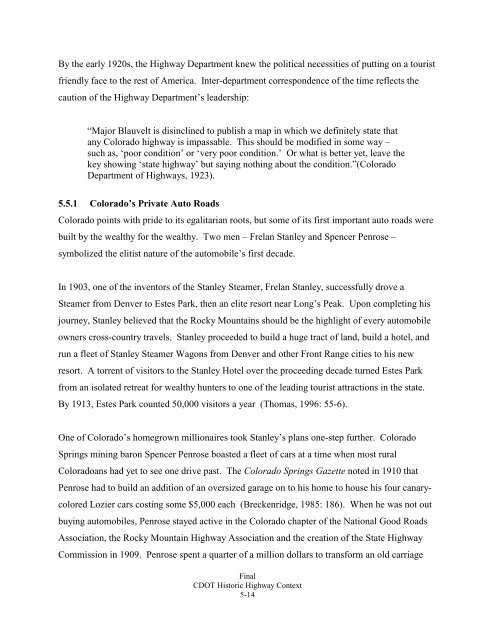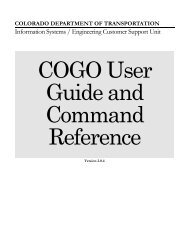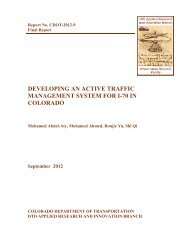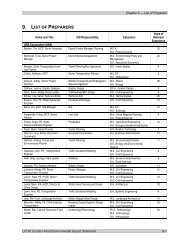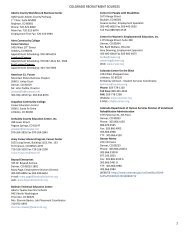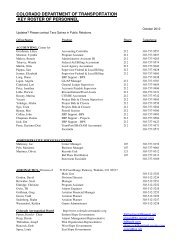Chapter 5 THE AUTOMOBILE AGE BEGINS, 1890-1930 - Colorado ...
Chapter 5 THE AUTOMOBILE AGE BEGINS, 1890-1930 - Colorado ...
Chapter 5 THE AUTOMOBILE AGE BEGINS, 1890-1930 - Colorado ...
You also want an ePaper? Increase the reach of your titles
YUMPU automatically turns print PDFs into web optimized ePapers that Google loves.
By the early 1920s, the Highway Department knew the political necessities of putting on a tourist<br />
friendly face to the rest of America. Inter-department correspondence of the time reflects the<br />
caution of the Highway Department’s leadership:<br />
“Major Blauvelt is disinclined to publish a map in which we definitely state that<br />
any <strong>Colorado</strong> highway is impassable. This should be modified in some way –<br />
such as, ‘poor condition’ or ‘very poor condition.’ Or what is better yet, leave the<br />
key showing ‘state highway’ but saying nothing about the condition.”(<strong>Colorado</strong><br />
Department of Highways, 1923).<br />
5.5.1 <strong>Colorado</strong>’s Private Auto Roads<br />
<strong>Colorado</strong> points with pride to its egalitarian roots, but some of its first important auto roads were<br />
built by the wealthy for the wealthy. Two men – Frelan Stanley and Spencer Penrose –<br />
symbolized the elitist nature of the automobile’s first decade.<br />
In 1903, one of the inventors of the Stanley Steamer, Frelan Stanley, successfully drove a<br />
Steamer from Denver to Estes Park, then an elite resort near Long’s Peak. Upon completing his<br />
journey, Stanley believed that the Rocky Mountains should be the highlight of every automobile<br />
owners cross-country travels. Stanley proceeded to build a huge tract of land, build a hotel, and<br />
run a fleet of Stanley Steamer Wagons from Denver and other Front Range cities to his new<br />
resort. A torrent of visitors to the Stanley Hotel over the proceeding decade turned Estes Park<br />
from an isolated retreat for wealthy hunters to one of the leading tourist attractions in the state.<br />
By 1913, Estes Park counted 50,000 visitors a year (Thomas, 1996: 55-6).<br />
One of <strong>Colorado</strong>’s homegrown millionaires took Stanley’s plans one-step further. <strong>Colorado</strong><br />
Springs mining baron Spencer Penrose boasted a fleet of cars at a time when most rural<br />
<strong>Colorado</strong>ans had yet to see one drive past. The <strong>Colorado</strong> Springs Gazette noted in 1910 that<br />
Penrose had to build an addition of an oversized garage on to his home to house his four canarycolored<br />
Lozier cars costing some $5,000 each (Breckenridge, 1985: 186). When he was not out<br />
buying automobiles, Penrose stayed active in the <strong>Colorado</strong> chapter of the National Good Roads<br />
Association, the Rocky Mountain Highway Association and the creation of the State Highway<br />
Commission in 1909. Penrose spent a quarter of a million dollars to transform an old carriage<br />
Final<br />
CDOT Historic Highway Context<br />
5-14


